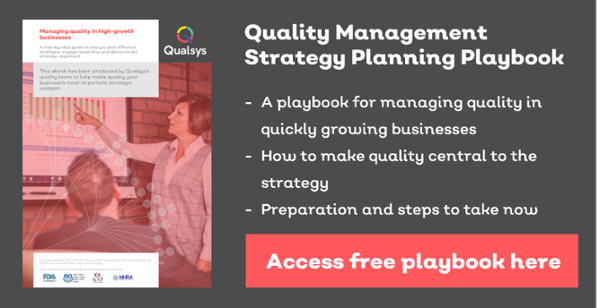Want to contribute to this article?
"Picture the scene.
It's time for the annual quality management review laid out in the requirements of ISO 9001.
The quality manager, with the support of their team, has spent several weeks gathering huge amounts of data.
They've checked that data religiously, from first time run rates to scrap levels, to make sure everything's exactly right - in case anyone notices the difference between 1.62% and 1.63%.
With trepidation, they walk into the board meeting. It's the graveyard slot over lunch so people can eat through it.
They rush through 110 slides of statistics as quickly as they can, take questions, give a few thanks to everyone, and thank God it's all over for another year."
Does Mark's account sound familiar?
Mark Eydman is the founder and lead consultant of Six Pillars Consulting, and he spoke to Qualsys about one of the main mistakes quality professionals make:
Failing to link quality and stakeholder interests together.
Mark offered us some tips and insights from his 20 years' experience for how quality professionals can start making the management review, and the entire quality role, begin to shine in their businesses.

Qualsys: Why does quality matter in the boardroom?
Mark: I looked at the CQI website before this interview and I found one of my favourite definitions of quality. Quality is about 'making organisations perform for their stakeholders'.
Quality and stakeholder interests are the same thing. If there's not an extremely high level of overlap in any business, something isn't working correctly.
But in the great majority of situations, businesses have a departmental view of quality and don't see it as an embedded, holistic, pan-organisational function. I find it extremely disappointing to see the limited role it's sometimes given to play.
Qualsys: What do you think is the first step to changing that?
Mark: Passion and understanding - I know that sounds like two steps!
I favour a patient approach and I think slowly winning over our audiences is key. After many years of travelling that path, I've learnt you catch many more flies with honey than with vinegar.
Telling people around the boardroom table about how important quality is will fail.
Speaking in quality language that we find interesting but nobody else does will fail.
We have to understand how to transmit the value of quality with passion and relevance.
Like many specialty groups, we too often use our own terms: OFIs, non-conformances, scrap rate, blah blah blah.
Quality and stakeholder interests are the same thing. If there's not an extremely high level of overlap in any business, something isn't working correctly.
It doesn't engage others. They either don't understand it or they find it of limited relevance.
Why should organisations really care about quality?
It's about helping businesses survive and thrive, protecting brand and reputation, it's about risk management, about building profits and customer loyalty and driving employee engagement. These are really powerful, compelling themes. This is what we should be articulating.
We need to choose the themes and the language our colleagues will respond to, not what we find interesting. That's the key to this.
We can't insist or tell. But we can make it as automatic for quality to be there as sales or finance or HR. Everyone expects them to be there.
And the quality professional has to be in charge of this transition. They have to understand what their colleagues' objectives are and how quality can support them. Everyone around the table in a management meeting will have a to do list and things they want to move forward. It's the role of the quality manager to make themselves invaluable in fixing those problems.
I look forward to a time when the quality management review is seen as such a value-add hour that you can sell tickets to it, rather than slotting it in over lunch so people can eat through the presentation.
And we have to make that transition.

Qualsys: If you could stop the quality manager with their 110 slides of data before they walk into the boardroom, what would you say to them?
Mark: Well, in a perfect world, many, many things would have been done before they walk into the boardroom.
I would ponder two main challenges:
1) I would want to know what the top 3 or 4 challenges are that the leadership team are contending with, then make sure my presentation helped solve those problems.
Let's imagine, for example, one issue is a new product launch, and the board has been wrestling with the best way to carry it out.
A quality manager could present customer feedback as part of their role. But rather than saying 'in the last month we had three complaints, and one was about late delivery, and one wasn't our fault' and so on, I would go in and tell the board who our top 30% most loyal customers are and why they are loyal, so the product launch can be aligned with that information and have the most chance of success.

2) I used to work in sales, so I learned in a 'pitch' it's not just about the information you provide. It's about how you make your prospect feel.
The emotional side doesn't come naturally to quality professionals and we need to tune our approach to it. Building excitement, building engagement, so people will come to you. You can't do that with the latest waste statistics.
If people want background data, a good quality manager should have it available. But the vast majority of the audience won't want to see it.
Quality professionals can't ask the board, 'please, you really should be more interested'. We have to sell the value ourselves.
I look forward to a time when the quality management review is seen as such a value-add hour that you can sell tickets to it, rather than slotting it in over lunch so people can eat through the presentation.
I had been quality manager at a previous business for three days before the management review was due. I decided to do something completely different. I got rid of PowerPoint and used plastic props on the boardroom table to show a process approach for making great chips, and how to add value: theatrical chips, potatoes, chopping knife, deep fat fryer.
I gave everyone a plastic potato prop after as a reminder of the day. And thank goodness it worked. Everyone present who didn't understand the ins and outs of quality remembered the potato presentation.
My position the next day was changed from quality manager to quality director and quality became a board position. I think it's absolutely vital that quality is represented on the top table, but it has to be on demonstrated value.
We can't insist or tell. But we can make it as automatic for quality to be there as sales or finance or HR. Everyone expects them to be there. And if we have the right people with the right tools, the right approach, the right training, they will expect quality to be there.

Making quality interesting: Qualsys Compliance Director
Kate Armitage speaks at a Qualsys event in 2019
Qualsys: What role do you think 'the right tools' can play in this transition?
Mark: I've worked in a quality role in businesses of every size. When you start your quality journey, it's possible to use paper and manual tools. But once you start to grow and mature and disperse, electronic tools become vital. They present data and information in a compelling manner and distribute it across the organisation.
I think other in than the most sensitive of situations, quality data should be shared as widely as possible for whoever wants to see it. My particular passion is customer loyalty, so things like customer feedback should be presented far and wide across the business.
These electronic systems have a huge role to play and can be very, very powerful.
Qualsys: How would you summarise where quality managers should go from here?
Mark: I would summarise with a rallying cry to the quality profession: we have a wonderful 'value proposition' to present.
It's incumbent on us to find new and imaginative and compelling ways to carry that message. I absolutely guarantee that if we can do that, we'll find more people to listen and let people do our great work.

Next steps
Read another interview with Mark: ISO 9001: customer satisfaction vs. loyalty.
And try our quality strategy playbook and start making quality central to your organisation:








Share your thoughts on this article